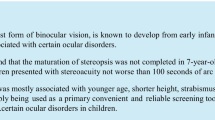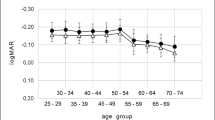Abstract
Purpose
To investigate the development of stereoscopic acuity (stereoacuity) in children longitudinally.
Methods
Seven full-term normal infants whose age at the beginning of the study was between 12 and 23 weeks were studied. A computer-based random-dot test of stereoscopic vision (TV-Random Dot Stereo Test) was used to measure stereoacuity. The test was repeated at 2- to 3-month intervals until the children reached 2 years of age, and then every 6 to 12 months until they reached 5 years of age.
Results
All of the infants were found to have a stereoacuity of 2480 seconds of arc (2480″) with this test by 26 weeks of age. The first reliable measurement of stereoacuity was obtained from a 16-week-old infant. Stereoacuity did not improve significantly between 6 and 12 months, but it improved rapidly after 12 months. All children had a stereoacuity of 100″ with the Titmus Stereo Tests at 5 years of age, but the best stereoacuity with the TV-Random Dot Stereo Test was 229″ at 28.9 months.
Conclusions
The development of stereoacuity studied longitudinally was similar to that obtained by cross-sectional studies. The TV-Random Dot Stereo Test is a useful program for measuring stereopsis in preverbal children. Jpn J Ophthalmol 2005;49:1–5 © Japanese Ophthalmological Society 2005
Similar content being viewed by others
Author information
Authors and Affiliations
Corresponding author
About this article
Cite this article
Takai, Y., Sato, M., Tan, R. et al. Development of Stereoscopic Acuity: Longitudinal Study Using a Computer-based Random-dot Stereo Test. Jpn J Ophthalmol 49, 1–5 (2005). https://doi.org/10.1007/s10384-004-0141-4
Received:
Accepted:
Issue Date:
DOI: https://doi.org/10.1007/s10384-004-0141-4




